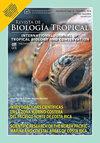Effect of ecoregion and river type on neotropical Chironomidae (Diptera) from humid mountain to semiarid lowland
IF 0.6
4区 生物学
Q4 BIOLOGY
引用次数: 1
Abstract
Introduction: Chironomidae (Diptera) is the most widespread and abundant aquatic insect family in freshwater ecosystems. Chironomids are considered good indicators of water quality but are seldom identified at the genus level in broad spatial scale studies. Objective: To identify environmental conditions associated with chironomids in an altitudinal gradient. Methods: We compared ecoregions, river types, and seasons, for chironomids in neotropical streams and rivers (18 river sites; 2014-2018; Yungas rainforest and Western Chaco dry forest, Argentina). We used non-metric multidimensional scaling, dissimilarity, envfit analysis and rank-abundance curves. Results: Chironomic “assemblages” matched both ecoregions and river types. However, ecoregions presented a better fit with species composition. The stenothermal taxa of Orthocladiinae were dominant at high elevations and the eurythermal Chironominae in lowland rivers. Altitude, water temperature and conductivity were important. Seasonal differences were smaller than ecoregional differences. Conclusions: Ecoregions, altitude, water temperature and conductivity correlated with chironomid communities. Orthocladiinae were dominant at high elevations and Chironominae in lowland rivers.生态区和河流类型对湿润山地至半干旱低地新热带摇蚊科的影响
简介:手蛾科(双翅目)是淡水生态系统中分布最广、数量最多的水生昆虫科。手拟虫被认为是水质的良好指标,但在广泛的空间尺度研究中很少在属水平上得到鉴定。目的:在不同的海拔梯度下,确定与摇蚊相关的环境条件。方法:比较新热带河流和河流的生态区域、河流类型和季节(18个河流站点;2014 - 2018;Yungas雨林和西部查科干林,阿根廷)。我们使用了非度量的多维尺度、不相似性、环境分析和等级丰度曲线。结果:群落“组合”与生态区域和河流类型相匹配。然而,生态区域与物种组成表现出更好的拟合。高海拔地区以低温热区为主,低海拔地区以低温热区为主。海拔、水温和电导率是重要因素。季节差异小于生态区域差异。结论:生态区域、海拔高度、水温和电导率与摇尾鱼群落相关。高海拔地区以正枝虫科为主,低海拔地区以Chironominae为主。
本文章由计算机程序翻译,如有差异,请以英文原文为准。
求助全文
约1分钟内获得全文
求助全文
来源期刊

Revista De Biologia Tropical
生物-生物学
CiteScore
1.80
自引率
0.00%
发文量
23
审稿时长
4-8 weeks
期刊介绍:
The Revista de Biología Tropical / International Journal of Tropical Biology and Conservation is a mainstream scientific journal published since 1953 and covered by Web of Science; Science Citation Index; Current Contents; Google Scholar; Scopus, SciELO and nearly 50 additional indices.
A double blind system guarantees you a fair evaluation, and our world class editorial and scientific boards provides a first decision in three working days. The journal is Full Open Access and is widely read where your article can have the highest real impact.
Since its beginning in 1953, the Revista follows these principles: objective and independent evaluation of all manuscripts; transparency in all processes; ethical use of procedures, data, specimens and subjects; fair treatment of all parties; and absolute predominance of scientific rigor over any other aspect.
 求助内容:
求助内容: 应助结果提醒方式:
应助结果提醒方式:


